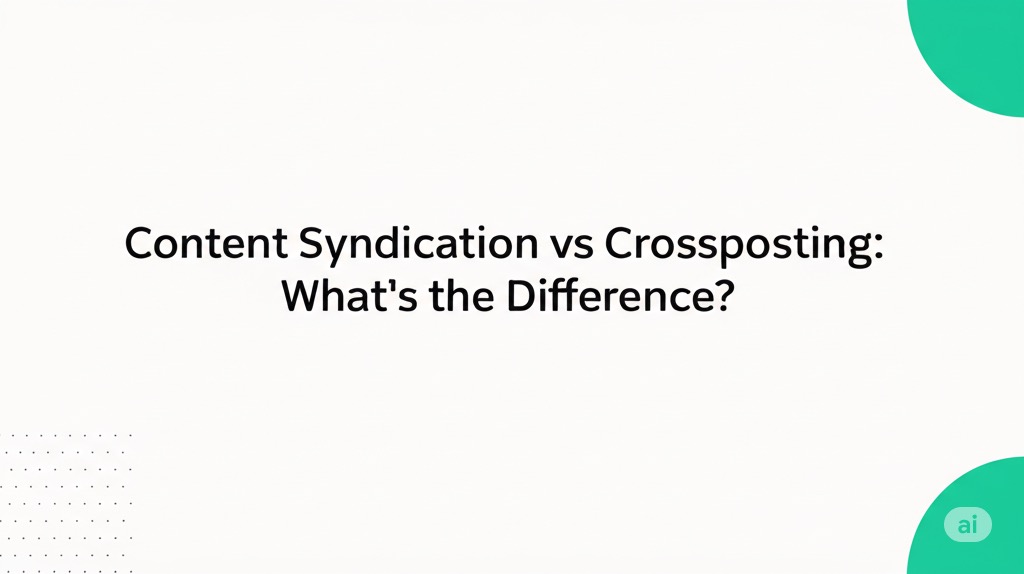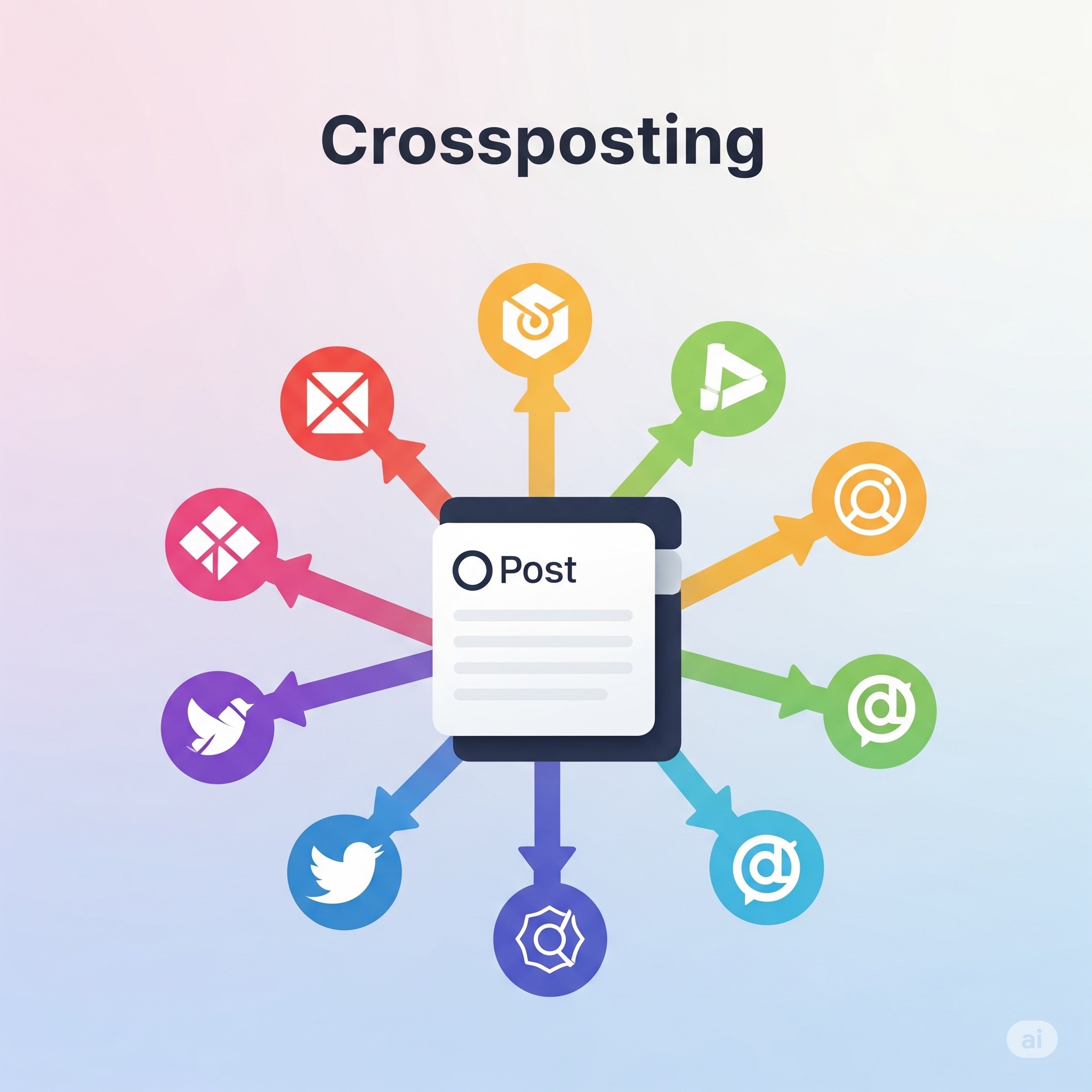Content Syndication vs Crossposting: What’s the Difference?
TL;DR:
Content syndication is when third parties republish your content (with credit).
Crossposting is when you publish the same content across multiple platforms yourself.

In the rapidly evolving digital landscape, content is king. Whether you’re a blogger, an entrepreneur, or a marketer, the ability to share and disseminate your content widely is crucial for building an audience and establishing authority in your niche. Two prevalent strategies for distributing content are content syndication and crossposting. While they may seem similar at first glance, they serve different purposes and have distinct implications for content creators and marketers. In this article, we will explore the nuances of content syndication and crossposting, helping you understand when and how to use each strategy effectively.
Understanding Content Syndication

Content syndication refers to the process of republishing your content on third-party sites, with the intent of reaching a broader audience. This practice can be beneficial in several ways:
-
Reach and Visibility: By syndicating your content, you can tap into the existing audience of larger platforms. This is particularly advantageous for new bloggers or brands looking to gain traction. For example, a well-established website in your niche may have thousands of visitors daily. If your article appears there, it can introduce your work to potential readers who may not have discovered you otherwise.
-
SEO Benefits: While some may worry about duplicate content penalties from search engines, reputable syndication platforms often include canonical tags that point back to the original article on your site. This means that search engines understand where the content originated, preserving your SEO ranking.
-
Brand Authority: Being featured on reputable sites can enhance your brand’s credibility. When audiences see your content on trusted platforms, they are more likely to view you as an authority in your field.
However, it’s essential to choose syndication partners wisely. Not all platforms offer the same benefits, and low-quality sites may harm your brand’s reputation.
The Concept of Crossposting

Crossposting, on the other hand, involves sharing the same piece of content across multiple platforms simultaneously, often with the intention of engaging different audiences on each platform. This technique is commonly used on social media channels, forums, and other online communities. Here are some key attributes of crossposting:
-
Audience Engagement: Different platforms attract different demographics and interests. By crossposting, you can engage with varied audiences, tailoring your content to fit the nuances of each platform. For instance, a professional article might be suitable for LinkedIn, while a more casual version could resonate better on Facebook or Twitter.
-
Consistency in Messaging: Crossposting allows for consistent messaging across various channels. When executed properly, this strategy reinforces your brand voice and keeps your audience informed, regardless of the platform they are using.
-
Time Efficiency: Content creation is a labor-intensive process. Crossposting allows you to maximize the value of your content by sharing it across multiple platforms quickly. This efficiency can be particularly beneficial for busy professionals who need to maintain an active online presence without dedicating excessive time to content creation.
However, crossposting can be tricky. Each platform has its own culture, and what works on one might not work on another. It’s important to adapt your content slightly—such as changing the tone or format—to suit the audience of each platform, rather than simply copying and pasting the same text everywhere.
Key Differences Between Syndication and Crossposting
While both content syndication and crossposting aim to increase visibility and reach, several key differences set them apart:
-
Purpose: The primary purpose of syndication is to leverage the audience of another platform to gain exposure, while crossposting focuses on engaging different audiences across multiple platforms simultaneously.
-
Control: In syndication, content creators often relinquish some control over how their content is presented, as it is republished by another site. In contrast, crossposting allows for more direct control, enabling you to tailor your content to fit each platform’s unique style and audience.
-
SEO Implications: Syndicated content typically includes canonical links, protecting the original source’s SEO ranking. Conversely, crossposting may not always have these safeguards, which could lead to duplicate content issues if not managed correctly.
Best Practices for Content Syndication and Crossposting
To make the most of both syndication and crossposting, consider the following best practices:
-
Choose the Right Platforms: For syndication, select reputable sites that align with your brand values and target audience. For crossposting, ensure that the platforms you choose are relevant to your content and conducive to engagement.
-
Tailor Your Content: When crossposting, it’s essential to slightly modify your content for each platform. This could mean changing the headline, adjusting the tone, or adding platform-specific elements (like hashtags for Twitter or images for Instagram).
-
Monitor Performance: Use analytics tools to track how your content performs across different platforms. This information can guide your future content strategy, helping you identify what works best for your audience.
-
Utilize Tools: Platforms like Crosspost can assist in simplifying crossposting efforts. This user-friendly tool enables you to schedule posts, track engagement, and streamline your content distribution process, ensuring consistency and efficiency.
Conclusion
In conclusion, both content syndication and crossposting are valuable strategies for increasing your content's reach and engagement. While they share a common goal of enhancing visibility, they differ significantly in their execution and implications for content creators. Understanding these differences will empower you to make informed decisions about how to share your content effectively.
By leveraging the right combination of syndication and crossposting, and utilizing tools like Crosspost, you can enhance your online presence, engage with diverse audiences, and ultimately achieve your content marketing goals. As the digital landscape continues to evolve, mastering these strategies will be essential for anyone looking to thrive in the competitive world of content creation.